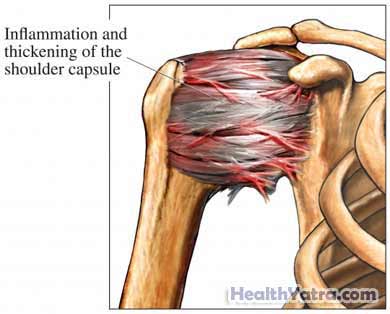تعريف
Adhesive capsulitis is a tightening in the shoulder joint. It decreases the range of motion in the shoulder and causes pain. This condition is also known as frozen shoulder. It is caused by tightening of the soft tissue and formation of scar tissue.
During this arthroscopic surgery, the doctor cuts and removes scar tissue around the shoulder. The goal of the procedure is to improve range-of-motion by breaking up scar tissue

أسباب هذا الإجراء
This procedure is done to:
- تخفيف الألم
- Restore range of motion in the shoulder joint
- Break up scar tissue
المضاعفات المحتملة
Complications are rare, but no procedure is completely free of risk. If you are planning to have arthroscopic shoulder surgery, your سيقوم الطبيب بمراجعة القائمة of possible complications which may include:
- نزيف
- العدوى
- الألم
- إصابة الأعصاب
- تلف الأنسجة الرخوة
- عدم استقرار أو تصلب المفصل
- كسر
- رد فعل على التخدير المستخدم
بعض العوامل التي قد تزيد من خطر المضاعفات تشمل:
- مرض حديث أو مزمن
- بعض الأدوية - خاصة تلك التي تزيد من النزيف (مثل الأسبرين)
- التدخين أو تعاطي الكحول
- جراحة سابقة في الكتف (قد تسبب ضررًا)
ما يمكن توقعه
قبل الإجراء
قد يقوم طبيبك بما يلي:
- اختبار بدني
- اختبارات الدم والبول
- الأشعة السينية - اختبار يستخدم الإشعاع لالتقاط صورة لهياكل داخل الجسم ، وخاصة العظام
- التصوير بالرنين المغناطيسي – اختبار يستخدم الموجات المغناطيسية لالتقاط صور للهياكل داخل الجسم
التحدث مع طبيبك عن الأدوية الخاصة بك. قد يطلب منك التوقف عن تناول بعض الأدوية تصل إلى أسبوع واحد قبل العملية مثل:
- الأسبرين أو غيره من العقاقير المضادة للالتهابات
- سيولة الدم, مثل كلوبيدوجريل (بلافيكس) أو الوارفارين (الكومادين)
قبل الإجراء:
- Arrange for a ride to and from the hospital. Also, arrange for help at home after the surgery.
- The night before, eat a light meal. Do not eat or drink anything after midnight. If you have diabetes, you may need to adjust your medicines. Talk to your doctor about this.
- If told to do so by your doctor, on the day of the surgery, shower using a special antibacterial soap. Do not use deodorant.
التخدير
General anesthesia is often used for this surgery. You will be asleep.
وصف الإجراء
Three small incisions will be made in your shoulder. A special tool called an arthroscope will be inserted. An arthroscope is a flexible tube with a light at the end and a camera attached. This will allow the doctor to view the inside of the shoulder on a screen. Tiny instruments will be inserted into the other incisions. The doctor will then cut and remove scar tissue. The incisions will be closed with stitches.
مباشرة بعد الإجراء
You will be taken to a recovery room after surgery. You will be monitored for any adverse reactions to surgery or anesthesia.
كم من الوقت سوف يستغرق
About 1-½ to 2 hours
كم هو مؤلم ؟
Anesthesia will block pain during the procedure. In some cases, the doctor implants a pain pump into the shoulder. This pump slowly delivers pain medicine. It may be used for the first couple of days and then removed. Afterwards, you will have medicine to help manage the pain.
متوسط الإقامة في المستشفى
If there are no complications, it may be possible to leave the hospital on the same day. Talk to your doctor to see if this is an option in your case.
رعاية ما بعد العملية
Your shoulder will be sore for a few weeks. It can take 3-6 months to fully recover.
When you return home, you may be asked to do the following to help ensure a smooth recovery:
- Ice the swollen area for the first 24-48 hours. Do this for 20-30 minutes at a time.
- النوم جالسًا أو على كرسي. ضع وسادة خلف كوعك.
- Change the dressing.
- اسأل طبيبك حول, عندما هي آمنة للاستحمام, السباحة, أو نقع في الماء.
- Take pain medicine. If you have a pain pump, this will be removed in 1-2 days.
- Return to the doctor in 7-14 days to have your stitches removed.
- Resume your regular diet when you are ready. You may need to start with a clear liquid diet.
- Use a sling if told to do so by your doctor. You may not need to use one, because it can cause stiffness.
- Work with a physical therapist at home to focus on range-of-motion exercises .
- تأكد من اتباع تعليمات طبيبك.
استدعاء الطبيب
بعد مغادرة المستشفى، اتصل بطبيبك في حالة حدوث أي مما يلي:
- Signs of infections, including fever and chills
- Redness, swelling, increasing pain, excessive bleeding, or discharge from the incision sites
- سعال أو صعوبة في التنفس أو ألم في الصدر
- الغثيان أو القيء الشديد
- يزداد الألم سوءًا أو يزداد التورم
- وخز أو تنميل لا يزول ، خاصة في الذراعين واليدين
في حالة الطوارئ ، اتصل على المساعدة الطبية على الفور.
